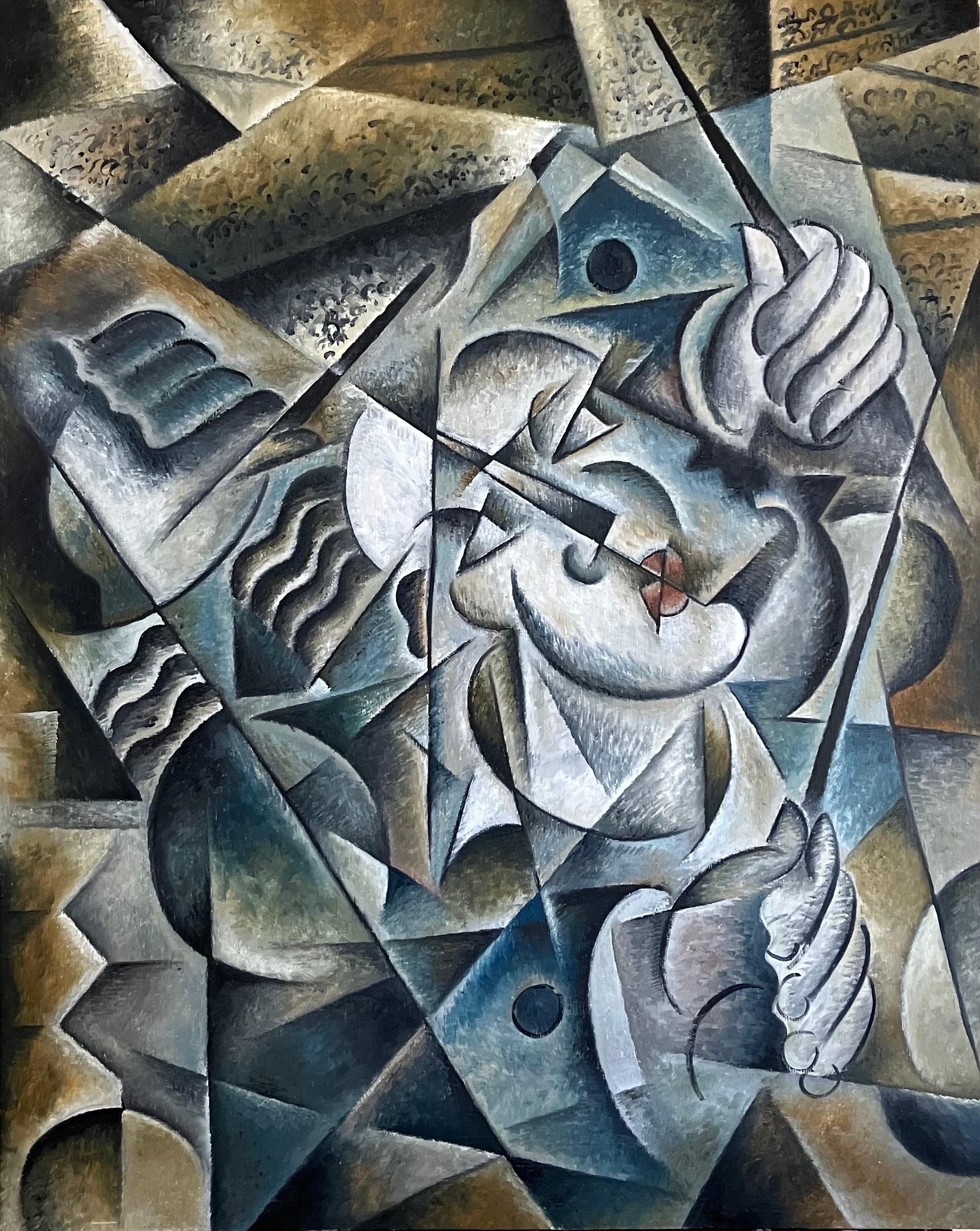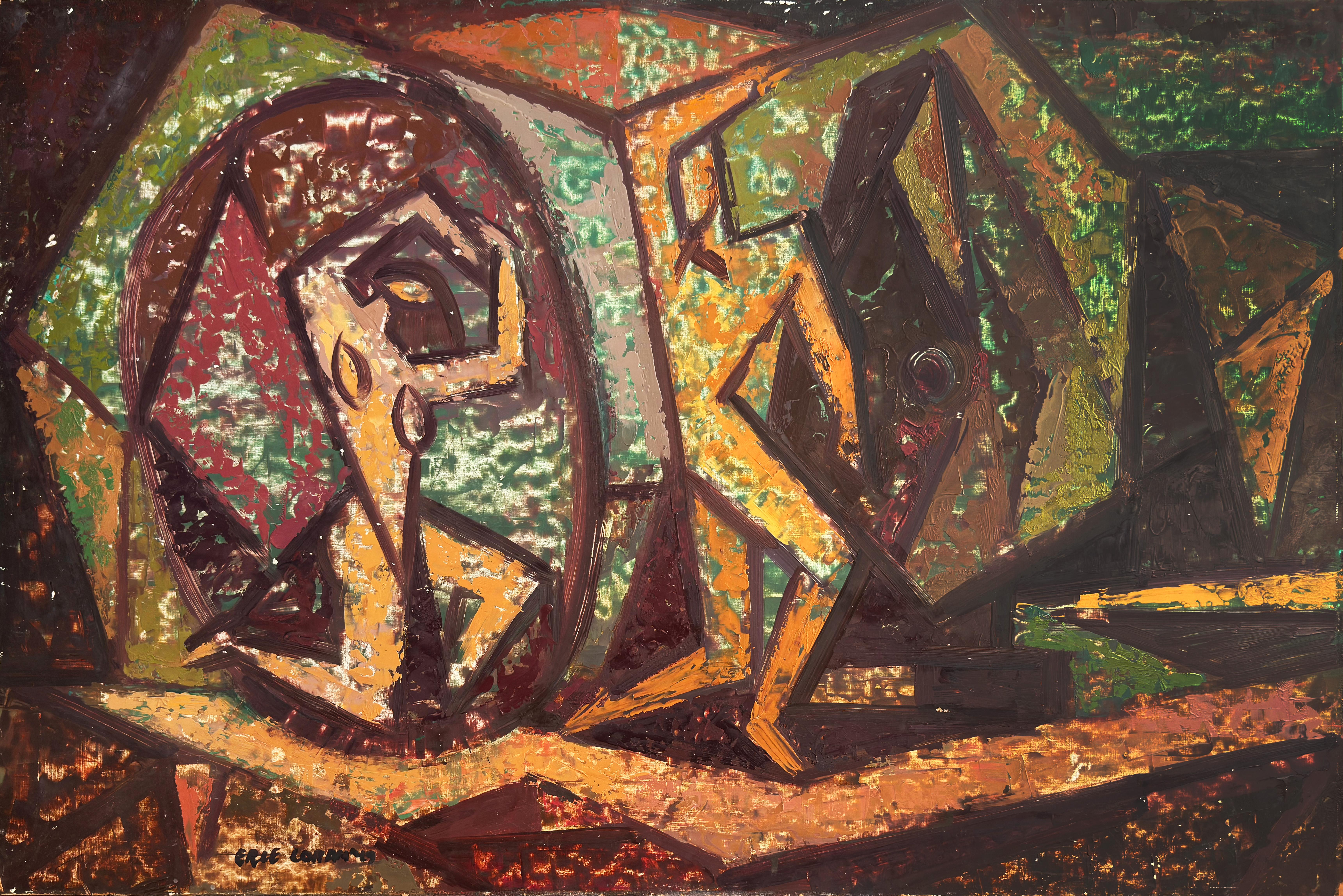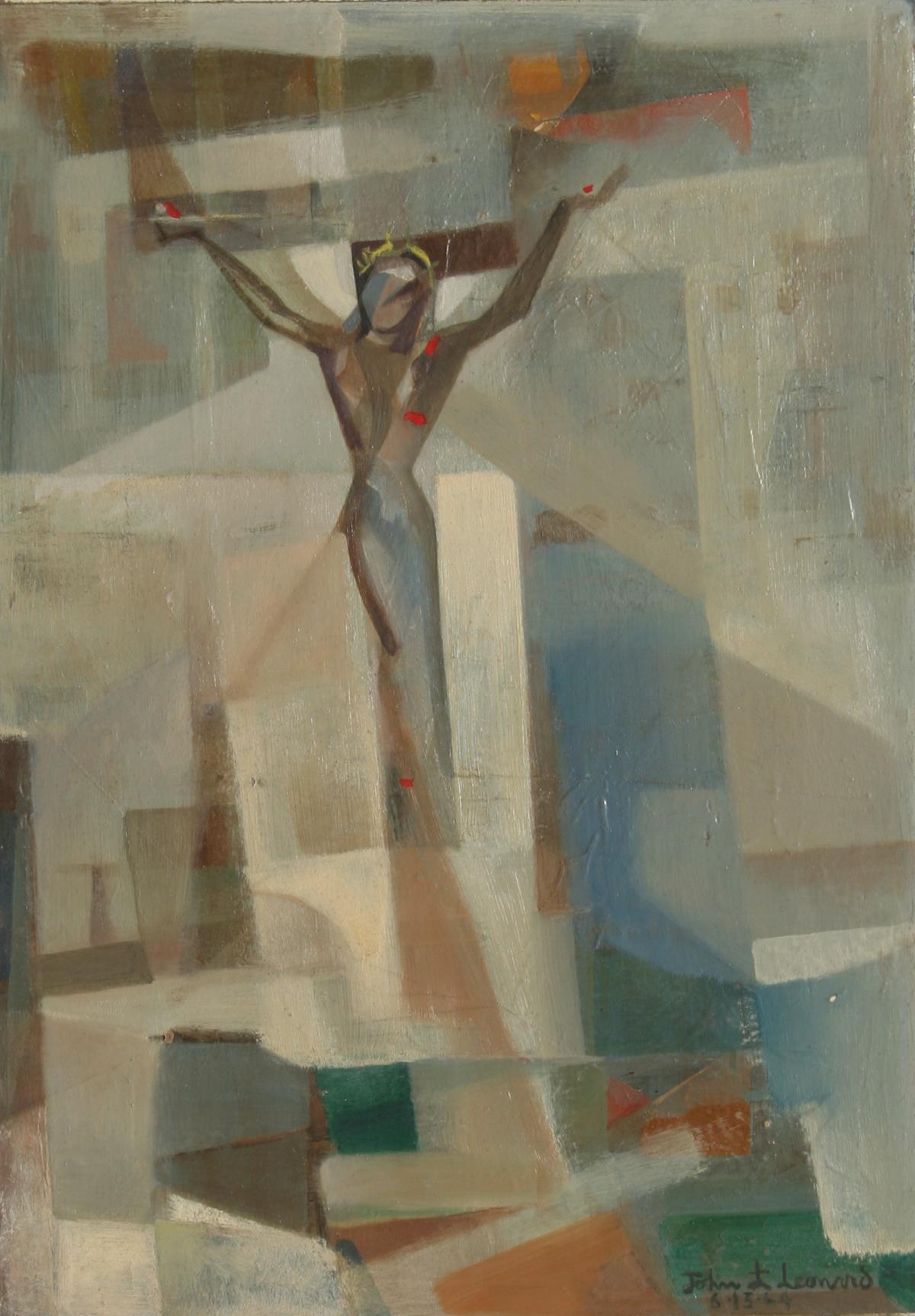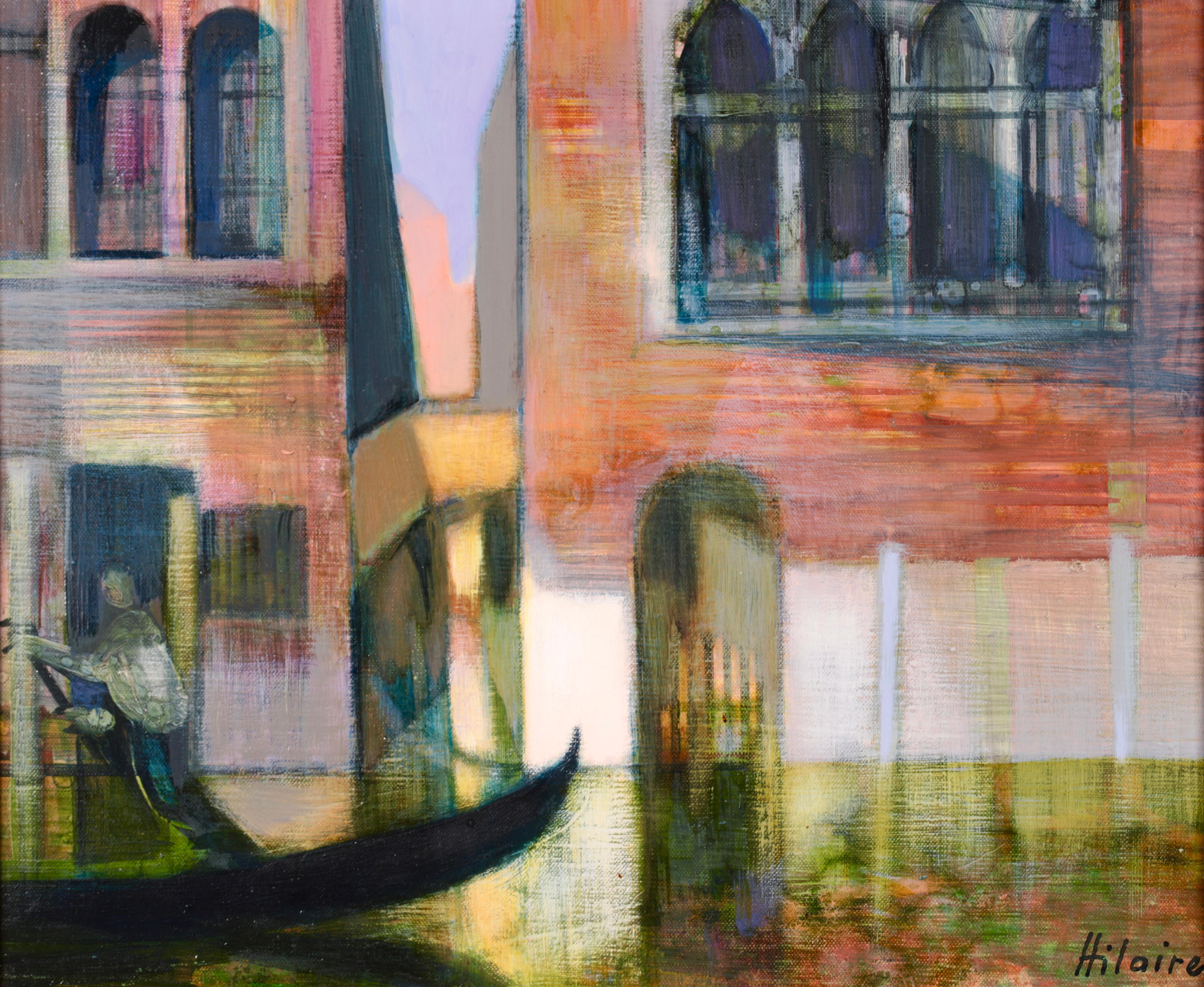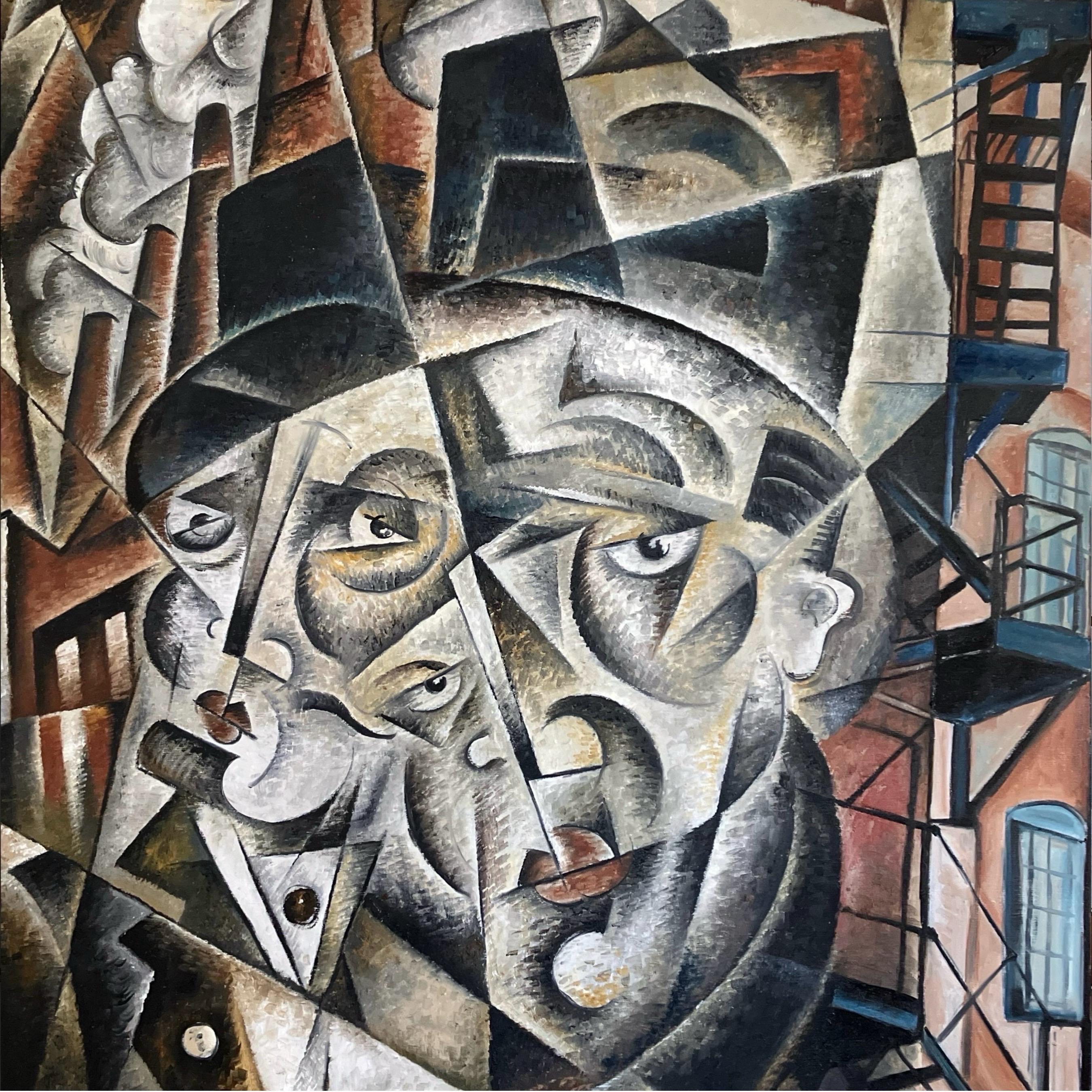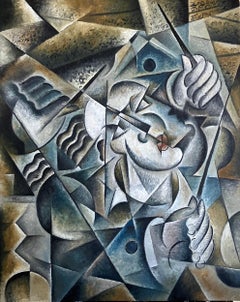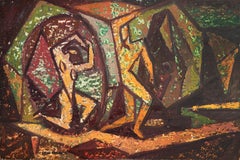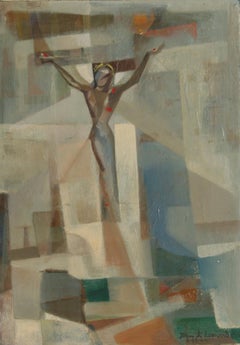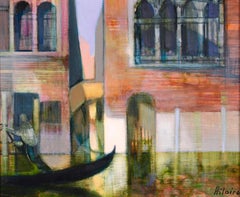Items Similar to Louis Toffoli - Brodeuse
Want more images or videos?
Request additional images or videos from the seller
1 of 6
Louis ToffoliLouis Toffoli - Brodeuse1970s
1970s
About the Item
Louis TOFFOLI (1928 - 1999)
Brodeuse
Signed lower right
Oil on canvas
55 x 38,1 cm
78 x 60 cm (Framed)
Louis TOFFOLI was born in Trieste, in Italy in 1907. After graduating from an Italian academy on arts, he escaped from the Fachism of Mussolini and settles in Paris where he died in 1999.
His paintings and lithographs are acknowledged all over the world. He has divers masterpieces exhibited in Germany, Brazil, Spain, Holland, Israel, Morocco, Portugal, Sweden and the USA. He was the one of the rare contemporary artists who had a museum named after him:: "Museum of TOFFOLI" in Charentons le Pont, south of Paris.
An established French artist, Louis Toffoli worked in a figurative style. He painted picturesque scenes in vibrant colors that also functioned as studies of human movement.
His pieces have a significant impact on the viewer; the transparent light pierces all forms and seems to emanate from the canvas. He painted what he loved and what he felt, The painter refuses with the facility, does not accept any concession and his work represents an essence of his relationship to the world around him. In addition to painting, he worked as a lithographer, a technique he learned while working for Fernand Mourlot.
The artist is in the search of an unusual interior truth, the colors and the lights vibrating in its paintings make sing the reasons for the fabric and charm the spectators.
- Creator:Louis Toffoli (1907 - 1999, French)
- Creation Year:1970s
- Dimensions:Height: 21.66 in (55 cm)Width: 14.97 in (38 cm)Depth: 0.4 in (1 cm)
- Medium:
- Movement & Style:
- Period:
- Condition:
- Gallery Location:Collonge Bellerive, Geneve, CH
- Reference Number:1stDibs: LU1612618562
Louis Toffoli
Louis Toffoli (1907-1999) was a French modernist artist, born in 1907, known for his characteristic post-cubist transparent paintings. A twentieth century French painter and printmaker, Louis Toffoli studied art at the Ecole des Beaux-Arts, Trieste in 1924. In 1928 he exhibited his paintings in that city and was promptly condemned by Mussolini's fascist regime. Two years later Toffoli emigrated to Paris and began regularly exhibiting. With the outbreak of the Second World War (1939-1945) Louis Toffoli sought refuge in the countryside of Touraine and worked for the French Resistance. After the war he returned to Paris and received his French citizenship in 1947. Today the fine art of Louis Toffoli is included in public galleries in Germany, Holland, Spain, Portugal, Italy, Sweden, America and Israel. The largest collection of his art is located at Le Musee Toffoli, Charenton-le-Pont (near Paris).
About the Seller
4.9
Platinum Seller
Premium sellers with a 4.7+ rating and 24-hour response times
Established in 2015
1stDibs seller since 2015
952 sales on 1stDibs
Typical response time: <1 hour
- ShippingRetrieving quote...Shipping from: Collonge Bellerive, Geneve, Switzerland
- Return Policy
Authenticity Guarantee
In the unlikely event there’s an issue with an item’s authenticity, contact us within 1 year for a full refund. DetailsMoney-Back Guarantee
If your item is not as described, is damaged in transit, or does not arrive, contact us within 7 days for a full refund. Details24-Hour Cancellation
You have a 24-hour grace period in which to reconsider your purchase, with no questions asked.Vetted Professional Sellers
Our world-class sellers must adhere to strict standards for service and quality, maintaining the integrity of our listings.Price-Match Guarantee
If you find that a seller listed the same item for a lower price elsewhere, we’ll match it.Trusted Global Delivery
Our best-in-class carrier network provides specialized shipping options worldwide, including custom delivery.More From This Seller
View AllAntonio Segui - Distraido - Oil on Canvas
By Antonio Seguí
Located in Collonge Bellerive, Geneve, CH
Antonio Segui
38 x 46 cm
Distraido
Oil on Canvas
Signed and Dated on the back
Antonio Segui Biography
Born in Córdoba, Argentina in 1934, Antonio Seguí currently lives and works in Paris. He studied at the San Fernando Academy in Madrid, Spain as well as the Ecole des Beaux-Arts in Paris, France. His first solo exhibition was in Argentina at age 23.
Antonio Seguí is one of the most internationally renowned Argentinian artists. He began his artistic endeavors at a young age after leaving Argentina to travel the world and study art. His journeys through Latin America, Europe and Africa exposed him to new ideas and encouraged his culturally diverse approach to art.
Influenced by artists like Fernand Leger and Diego Rivera, Seguí’s work is generally satirical, critiquing society and human nature. In a pre-computer age, the artist created a vocabulary that is now being explored by a new generation of artists through comics and Manga, yet his visual language and social commentaries remain poignant, both symbolically and literally.
Throughout his career, Seguí has developed a fascination for urban life, creating in his work the idea of the “everyman.” The city movement, the fast pace at which life happens and the people who live in these urban spaces are some of the elements that constitute the world depicted in his paintings. It is a prototypical realm inhabited by speedy automatons that take immutable routes leading nowhere. Up close, each figure is an individual, walking down dark alleys, pointing, waving and emerging from potholes. But from a distance, the individuals morph into complex patterns swallowed up in a labyrinth of buildings and cookie-cutter trees.
Utilizing cubist techniques, Seguí’s repeated elements give shape to the cities causing planes to vibrate between line and color. Numerous perspectives unfold with each vibration and reflect the many angles of life of the urban man. Always in action, the little figures trample, tip-toe, dodge and advance through Seguí’s imaginary metropolis of life.
His work is representated on a series of narratives and criticisms reflected on paintings that show many little men, dressed in 20's style clothes. He uses his own recourse based on comic strip characters, texts, arrows and various signs, juxtaposed onto the figures that resemble comic strip style language.
Seguí’s work is collected and exhibited worldwide in places such as the MoMA, New York; Art Museum of the Americas, Washington, D.C.; Frissiras Museum, Athens, Greece; Museo de Arte Moderno de Buenos Aires, Argentina; Museum der Moderne Salzburg, Austria; Museum of Modern Art Dubrovnik, Croatia; and Museo Tamayo, Mexico City, Mexico. The Musée National d´Art Moderne, Paris organized a retrospective of his works on paper in 2005. A monograph on the artist by Daniel Abadie was published in 2010 by Hazan.
Antonio Segui Resumé
1995
Art Miami '95, USA.
S. Zannettacci, Geneva, Switzerland
Marwan Hoss, Paris, France
Gallerie du Cirque Divers, Belgium
Le Moulin du Roc, France
Fundacao C. Gulbenkaian, Portugal
Gallerie J. Rubeiz, Beirut, Liban
1994
F. Santos, Portugal
E. Franck Gallery, Belgium
1993
Galleria San Carlo, Milan, Italy
Galería I. Vega, Puerto Rico
Winance-Sabbe, Belgium
FIAC, Paris, France
1992
Casa Rosada, Buenos Aires, Argentina
Espace Julio Gonzales...
Category
2010s Modern Figurative Paintings
Materials
Oil
Yoel Benharrouche - The Wise Man of Time - Oil on Canvas
By Yoel Benharrouche
Located in Collonge Bellerive, Geneve, CH
Yoel Benharrouche
Oil on Canvas
Title: The Wise Man of Time
Dimensions: 33 x 24 cm
Framed dimensions: 73 x 63 cm
Signed
"Spirit must meet with matter. Th...
Category
21st Century and Contemporary Contemporary Figurative Paintings
Materials
Oil
$5,153 Sale Price
40% Off
M.Chat - Untitled - Street Art Signed Painting
By M. Chat
Located in Collonge Bellerive, Geneve, CH
M. CHAT
Untitled
Painting mounted on canvas
Signed
Dimensions : 120 x 120 cm including frame
Framed painting
Avec certificat
Discreet and unobtrusive, Monsieur Chat or M. Chat has been working on the streets since he was 15. His anonymity was broken in 2007 when he was caught painting his famous symbol – the cat. The man behind the mask was revealed to be Thoma Vuille, but he didn’t allow himself to be disturbed by this. Instead, he continued to exacerbate the already crystallized curiosity around the urban graphics of his increasingly present symbol. The shadow of his anonymous existence dispersed upon being shined on, but in the end, he realized that he and his alter ego are one and the same person, so he learned to drop the mask and raise his name alongside the signature of his alter ego. Believing in the idea and repeating it continuously over time, the artist got to the point where he was able to shape those around him in a way that, ultimately, the image he projects outwards is reflected back at him at times when he starts to entertain his own doubts about it.
Throughout the World
Born in Boudry, in the canton of Neuchâtel, Switzerland, Chat began roaming the streets around 1987. He studied at the Institute of visual Arts of Orléans, graduating in 2001. In 1997, during one of the workshops, the grinning cat was born. In his, now omnipresent symbol, the culture of the neighborhood meets the never-ending optimism of the artist, making a combination that is easily recognizable and widely famous. His dream of uniting human beings, different as they might be, is now possible. That single unifying subject has been found, and he’s ever since on a mission of spreading that subject throughout the world. It was this kind of contagious optimism that nudged the film-maker Chris Marker into approaching the artist, and eventually making a documentary about him in 2004. Reflecting on France’s state after the 9/11, Marker used the phenomenon of the Chat’s cat to explore the sad feelings of the people, but to share some optimism as well. The attention was not focused on the artist, for once, as we do not need to know his personal history to be able to feel something upon seeing his work. In fact, the state of mind, or an attitude, or a philosophical aspiration, is represented through an image. Behind that image lies all the simplicity of a smile painted on a wall, and all the power that comes with it. Vuille keeps the drawing simple and the line clear. On the first sight, the cat looks like a logo. However, it can’t be reduced to a logo, as it’s so much more than that. Belonging to street art, it’s a character with a strong identity and many variations. A character that achieves a symbolic dimension through its simplicity.
A Dispute with RATP – Let Art Be Free
Street art is highly unpredictable – where one sees inspirational pieces, others see the destruction of property. The artist had been previously arrested on brush in hand by the Police Municipal of Orléans in 2007. The Régie autonome des transports Parisian demanded 1,800 euros in damages, stating that Vuille had, without prior authorization, drawn inscriptions, signs or drawings, in the case of Cat Heads on the walls of the Châtelet-Les Halles station during its renovation in May 2014. Due to some contradictories, Vuille’s lawyer raised the invalidity of the notice of the artist, stating that he and his client were not completely sure what they were accused of. The court found the nullity of the summons, and the RATP finally asked one euro in damages, an amount incomparable to their previous requests. The whole thing turned out to be nothing more than a bad memory for Monsieur Chat, stating that he was not a criminal, but an artist. He also explained that his intention was to humanize a transit corridor, which was gray. All he did was putting some color on it, sharing happy feelings with all who passed nearby.
Discreet and unobtrusive, Monsieur Chat or M. Chat has been working on the streets since he was 15. His anonymity was broken in 2007 when he was caught painting his famous symbol – the cat. The man behind the mask was revealed to be Thoma Vuille, but he didn’t allow himself to be disturbed by this. Instead, he continued to exacerbate the already crystallized curiosity around the urban graphics of his increasingly present symbol. The shadow of his anonymous existence dispersed upon being shined on, but in the end, he realized that he and his alter ego are one and the same person, so he learned to drop the mask and raise his name alongside the signature of his alter ego. Believing in the idea and repeating it continuously over time, the artist got to the point where he was able to shape those around him in a way that, ultimately, the image he projects outwards is reflected back at him at times when he starts to entertain his own doubts about it.
city english cookies video
Monsieur Chat – Siesta à Paris, 2016 (Left) / Sky With Dufy, 2016 (Right), image courtesy of Galerie Brugier-Rigail
Throughout the World
Born in Boudry, in the canton of Neuchâtel, Switzerland, Chat began roaming the streets around 1987. He studied at the Institute of visual Arts of Orléans, graduating in 2001. In 1997, during one of the workshops, the grinning cat was born. In his, now omnipresent symbol, the culture of the neighborhood meets the never-ending optimism of the artist, making a combination that is easily recognizable and widely famous. His dream of uniting human beings, different as they might be, is now possible. That single unifying subject has been found, and he’s ever since on a mission of spreading that subject throughout the world. It was this kind of contagious optimism that nudged the film-maker Chris Marker into approaching the artist, and eventually making a documentary about him in 2004. Reflecting on France’s state after the 9/11, Marker used the phenomenon of the Chat’s cat to explore the sad feelings of the people, but to share some optimism as well. The attention was not focused on the artist, for once, as we do not need to know his personal history to be able to feel something upon seeing his work. In fact, the state of mind, or an attitude, or a philosophical aspiration, is represented through an image. Behind that image lies all the simplicity of a smile painted on a wall, and all the power that comes with it. Vuille keeps the drawing simple and the line clear. On the first sight, the cat looks like a logo. However, it can’t be reduced to a logo, as it’s so much more than that. Belonging to street art, it’s a character with a strong identity and many variations. A character that achieves a symbolic dimension through its simplicity.
The simplicity of the smile painted on a wall represents the state of mind
page france french
Monsieur Chat – Le Masque...
Category
21st Century and Contemporary Street Art Animal Paintings
Materials
Canvas
Robert Marc - Untitled - Signed Oil on Canvas
By Robert Marc
Located in Collonge Bellerive, Geneve, CH
Robert Marc
Untitled
Oil on Canvas
Signed
60 x 80 cm
80 x 100 cm (Framed)
The painting is rich and complex with a palette and surface quality that warms and harmonises his ge...
Category
1950s Cubist Abstract Paintings
Materials
Oil
After Georges Braque - Antiborée - Lithograph
Located in Collonge Bellerive, Geneve, CH
Lithograph after Georges Braque.
Signed in the plate
Edition of 150
Dimensions: 76 x 117 cm
Bibliography:
« Les Métamorphoses de Braque» of Heger de Loewenfeld and Raphaël de Cuttoli , Editions FAC, Paris, 1989.
In 1961 Georges Braque decided with his laidary friend Heger de Loewenfeld to pick up certain of his works to in order to create artworks, this beautiful litograph is one of them.
Héméra in the Mythology:
In Greek mythology Hemera was the personification of day and one of the Greek primordial deities. She is the goddess of the daytime and, according to Hesiod, the daughter of Erebus and Nyx (the goddess of night). Hemera is remarked upon in Cicero's De Natura Deorum, where it is logically determined that Dies (Hemera) must be a god, if Uranus is a god. The poet Bacchylides states that Nyx and Chronos are the parents, but Hyginus in his preface to the Fabulae mentions Chaos as the mother/father and Nyx as her sister.
She was the female counterpart of her brother and consort, Aether (Light), but neither of them figured actively in myth or cult. Hyginus lists their children as Uranus, Gaia, and Thalassa (the primordial sea goddess), while Hesiod only lists Thalassa as their child.
The father of Cubism
Three Cubist that distinguishes art historian periods were initiated and developed by Georges Braque: The Cubist Cézanne (1907-1909), Executive (1909-1912) and synthetic (1912-1922).
Post-Impressionist and fawn, Braque no longer adheres to the contingency of a decorative way or the other. Cézanne’s paintings exhibited at the Grand Palais during the retrospective of 1907 are a revelation: Cézanne sought and invented a pictorial language. In his footsteps, Braque went to the South with the reasons of the Master. He returned with Estaque landscapes and surprising Ciotat it keeps Cezanne geometric model and retains the “passages” continuity from one surface to another to create the sensation of “turning around” of the object represented. But he wants to go after the consequences of the vision of Cezanne. In his paintings Houses in L’Estaque (1908) it simplifies the volumes of houses, neglects detail by removing doors and windows: the plastic rhythm that builds the table. Large Nude , a masterpiece of the period, can be considered the first work of Cézanne cubism .
Systematizing and deepening Braque discoveries open the door analytical cubism. In 1909, his painting became more cerebral than sensual. The pattern is recreated in the two-dimensionality of the canvas, leaving aside any illusionistic perspective. In Still Life with Violin, objects are analyzed facets according to their characteristic elements, each facet referring to a particular view of the object. There are so many facets of points selected view: Table reflects the knowledge of the object and the ubiquity of the eye. Moreover, Braque is looking for the essence of the objects in the world rather than their contingency, which explains the absence of light source and use of muted colors (gray, ocher), contingent aspects of the object . But formal logic has stepped facets, erased any anecdote to the object and ultimately led to his painting a hermetic more marked on the edge of abstraction (see the series of Castle Roche-Guyon ).
Braque, anxious to keep the concrete and refusing at all costs that the logic of Cubism takes the paintings to abstract, reintroduced signs of reality in his paintings in 1912 marks the beginning of Synthetic Cubism. Historians speak of “signs of real” rather than reality because what interests Braque, this is not to put reality into a table, but to create a painting which, by its language, refers to the real. To do this, he invented two major techniques XX th century inclusions and contributions. The inclusions consist of painting objects that have no real depth, materials (wallpaper in Nature morte aux playing cards faux wood is a pictorial inclusion) or letters (calligraphic inclusion in Portuguese ), made first brush and a few months later stencil. Contributions are defined in contrast with the collage on canvas of foreign materials: glued or sand paper, sawdust, etc.. Regarding the collages, Braque used for the first time in September 1912 a piece of adhesive paper imitating faux wood Compote...
Category
1950s Cubist Animal Prints
Materials
Lithograph
Jean Cocteau - Europe's Agriculture - Original Lithograph
By Jean Cocteau
Located in Collonge Bellerive, Geneve, CH
Original Lithograph by Jean Cocteau
Title: Europe's Agriculture
Signed in the stone/printed signature
Dimensions: 33 x 46 cm
Luxury impression from the portfolio published by Sciaky....
Category
1960s Cubist Animal Prints
Materials
Lithograph
You May Also Like
The Conductor
Located in Los Angeles, CA
Pascal Jarrion was born in Perpignan, France, in 1961. It is a region known for its Catalan culture and an area that has influenced many artists before him including Picasso, Van Gog...
Category
21st Century and Contemporary Cubist Figurative Paintings
Materials
Oil, Wood Panel
Orpheus and Eurydice, Mythological Cubist Oil Painting by Erle Loran
By Erle Loran
Located in Long Island City, NY
Orpheus and Eurydice
Erle Loran, American (1905–1999)
Date: 1949
Oil on Masonite, signed and dated lower left
Size: 24 x 36 inches
Category
1940s Cubist Figurative Paintings
Materials
Oil, Masonite
Crucifixion, Cubist Oil on Board Signed Painting by John F. Leonard
Located in Long Island City, NY
Crucifixion (36)
John F. Leonard
American (1921–1987)
Date: 1964
Oil on Board, signed
Size: 21.5 in. x 15 in. (54.61 cm x 38.1 cm)
Category
1960s Cubist Figurative Paintings
Materials
Oil, Board
Vieux palais sur la canal - Venice - Cubist Landscape Oil by Camille Hilaire
By Camille Hilaire
Located in Marlow, Buckinghamshire
Signed and titled cubist oil on canvas circa 1980 by French painter Camille Hilaire. This wonderful and colourful piece depicts a gondola on the Grand Canal, Venice with old palace behind.
Signature:
Signed lower right and titled verso
Dimensions:
Framed size: 21"x24" (53.3cm x 61.0cm)
Size: 15"x18" (38.1cm x 45.7cm)
Provenance:
Private French collection
Camille Hilaire was a pupil at the École des Beaux-Arts in Paris. He also worked in the free academies, including that of André Lhote, whose teaching had a major influence on his work.
He executed numerous mural decorations...
Category
1980s Cubist Landscape Paintings
Materials
Canvas, Oil
Vendimia - Grape Harvest
By Georges Dayez
Located in Berlin, MD
Georges Dayez (French, 1907-1991). “Vendimia” Vintage / Grape Harvest / Wine Harvest , Oil on paper, 20”x 26 1/3, framed 27 1/4 x 33 1/4.
Dayez was a...
Category
1950s Cubist Figurative Paintings
Materials
Oil, Paper, Board
Progress
Located in Los Angeles, CA
PASCAL JARRION
"PROGRESS"
OIL ON PANEL, SIGNED
2024
36 X 30 INCHES
_____________________________________________________________
__________
Pascal Jarrion was born in Perpigna...
Category
21st Century and Contemporary Cubist Figurative Paintings
Materials
Oil, Panel
Recently Viewed
View AllMore Ways To Browse
Louis Dor
Lithograph Portugal
Portugal Lithograph
Vintage Downtown Los Gatos California Street Scene
Vintage Oil Painting Village Scape
Vintage Pappagallo
Vivian Huebler
Vladan Stiha
Walt Peregoy
Walter Prescher Van Ed
Western Tissue Boxes Paper Mache
Whorf Nancy
Wilhelm Sasnal
William Betts
William Constable Adam On Sale
William Joseph Julius Caesar Bond
Wilmotte Williams
Window View With Chair Cloud Painting
